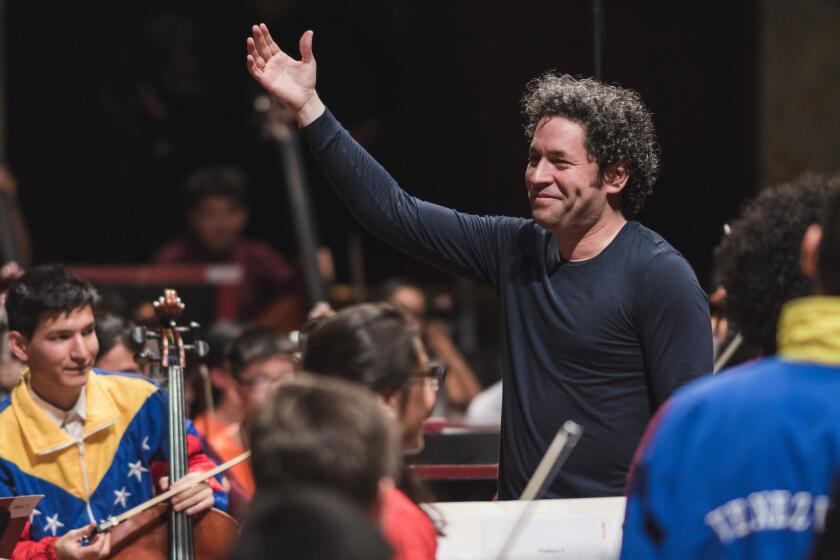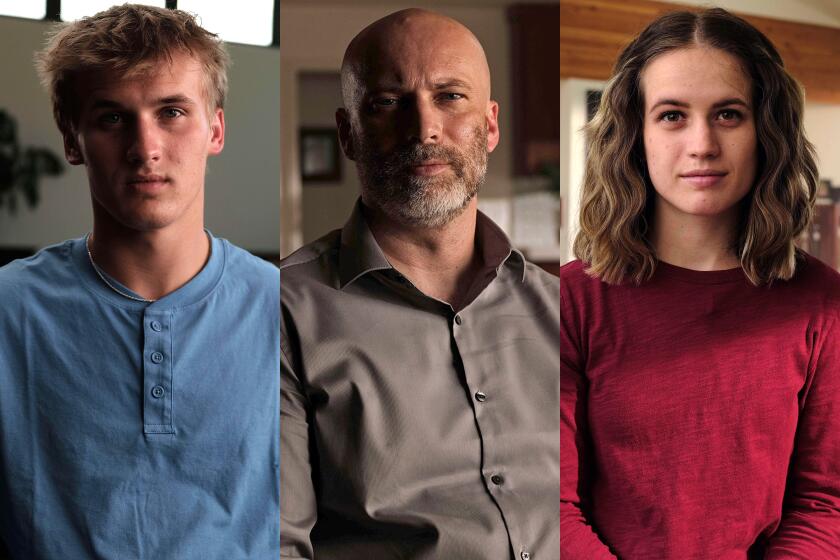ART : Pally Recognizes His Bond With ‘Interpretive Link’
- Share via
A year ago, the Newport Harbor Art Museum had a show called “The Interpretive Link,” which examined the fine threads that tied the Abstract Surrealism of such largely European artists as Arshile Gorky and Andre Masson to the Abstract Expressionism that blossomed in this country mid-century with such artists as Jackson Pollock and Barnett Newman.
Now the museum is offering recent work by Los Angeles artist Marc Pally in a one-man show organized by associate curator Anne Ayres. Pally’s forms resonate with similarities to many in “The Interpretive Link”--especially those of Gorky--in the way they suggest aquatic or vegetative life on the one hand and purely geometric designs on the other.
Pally, 42, lives in Hollywood and doesn’t shy away from the comparisons with Gorky and Masson. He saw the “The Interpretive Link” and instantly responded to a question about his reactions to the show by exclaiming: “The link continues!”
Then he went into more detail:
“Arshile Gorky is not somebody I knew well, but after I’d formed my own language I saw the association. I love (Chilean-born Surrealist Roberto) Matta. I don’t know that I consider them my forefathers, but it fits right in with what I do. Absolutely.”
The elements that give him this bond with Gorky and other members of that generation are also those that make precise verbal description of the work a challenge. They are shapes that might seem like a flower, or a fish or a leafy growth, but they are not representations. “It is difficult to pin them down,” Pally said with a shrug when asked to explain the shapes. He is a soft-spoken, dark-haired, unassuming man who seemed eager to talk about his art as he sat in his studio--a converted garage behind his house. Still, asked for a brief description of what he wants to convey with his work, he pondered awhile. Then he said: “The construction of meaning can never be assumed. Meaning is a process, never a completed thing.”
His method is to playfully combine colorful painting with drawing, visual fullness with partial, sketchy patterns. “You see how much drawing there is on the canvas,” Pally said, pointing to examples of his work that hang on the studio walls. “It calls that relationship (between painting and drawing) into question.”
His media include oil, acrylic, graphite, ink, oil stick, colored pencil, charcoal, enamel, acrylic modeling paste compounds, white shellac and various varnishes.
Pally’s work hangs in a show within the museum’s current show of work by graduates of the California Institute of the Arts. The CalArts image is rooted in conceptualism, the art of ideas, art as commentary. Yet Pally, a CalArts graduate, doesn’t fit the school’s aesthetic mold.
His work, he said, “deals with the mind as an expressive experience, as opposed to the personality which you might associate with expressive art. I’m not expressing my soul here. . . . I don’t agree with the dichotomy of the mind and the senses. If you say the work is cerebral, some people might wonder, ‘Is it also sensual?’ I want it to be both.”
It may sound as if inwardness is the hallmark of Pally’s work, but there is also a gregariousness to it. “I think of the work as very open,” said Pally, who grew up in Sherman Oaks and graduated from CalArts in 1978.
He has been an administrator for the public art program of the Los Angeles Community Development Agency.
“I’d like to do public art someday,” he said. “I don’t see myself standing in a studio all the time painting. I wonder if I’m going to stay with painting. I could see myself doing something very different years from now.”
He decided to become an artist in college, during a year spent in London. He started visiting museums there and attending art classes. “It is not like any American art education. The English know how to talk about art. I would be looking at a red circle on a green field and some guy would talk for 30 minutes about it.”
Another place where they know how to talk about art, where the intellectual discourse is interwoven with practice, is CalArts. “CalArts was very important to me,” Pally said. “It was a very important exposure to different perspectives. But I try thinking of myself as not being part of the CalArts scene. One thinks (of CalArts graduates) in terms of photographic work, not so much in terms of painting.”
Still, Pally has roots in some of the more conceptual ideals pervasive on the CalArts campus in Valencia. “My MFA thesis was on money,” he said. “I was trying to sabotage the U. S. economy. I took quarters and silk-screened (on to them) the faces of 100 Americans who had been bypassed by history. And I manipulated every dollar bill that passed through my hands for six months. I punched holes in dollars. I pounded a quarter down until it was 6 inches in diameter. I dropped another quarter in acid.”
But shortly after graduating, he turned to painting.
Palley, having achieved a measure of local recognition, will try in the coming year to extend his reputation to New York City, which he views as still being the American art world--though Los Angeles is becoming increasingly prominent.
“Los Angeles compared to New York used to be like a marble compared to a watermelon,” he said. “Now, it’s like a tennis ball compared to a watermelon. . . . I really hate having to go hustle my work, but it’s something I’ve promised myself that I will do.”
More to Read
The biggest entertainment stories
Get our big stories about Hollywood, film, television, music, arts, culture and more right in your inbox as soon as they publish.
You may occasionally receive promotional content from the Los Angeles Times.










